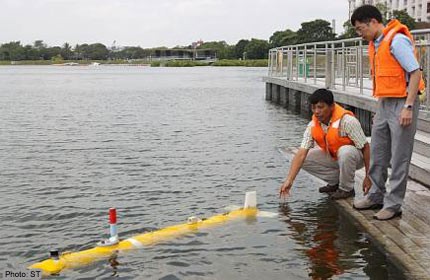Cheaper sensor to check water quality

A WATER-QUALITY sensor being developed in Singapore will cost nearly half the price of similar systems now in the market, which could be a boon for local fish farmers on a tight budget.
It will be able to detect - within seconds - more than 100 types of organic and inorganic substances found in waters here.
These include chlorophyll, which can indicate the presence of algal blooms deadly to fish. It can also detect low levels of dissolved oxygen in water.
Both of these were cited as factors when 160 tonnes of fish died at 39 farms in Singapore's northern waters earlier this month.
The cake-size sensor being built by scientists from the Singapore-MIT Alliance for Research and Technology (Smart) can warn farmers through a cellphone message when chlorophyll levels spike or oxygen levels get dangerously low.
It can also be configured to activate farms' aeration systems to add oxygen to the water.
The sensor's development, which began in 2009, was funded by the National Research Foundation. It is being commercialised by a local water technology start-up firm, which Smart research scientist Kelvin Ng declined to name.
The sensor is expected to cost around $25,000, compared with up to $40,000 for similar sensors, he said, adding that pre-orders can already be made.
Calling it a "lower-cost" option for fish farmers, Dr Ng said: "It would be very easy for them to use. The sensor will interpret the data in layman's terms for them."
Singapore Marine Aquaculture Cooperative chairman Phillip Lim said that $25,000 for an early warning system such as this "was a very good price" but stressed that it would first have to be tested to prove its effectiveness in preventing mass fish deaths.
Dr Ng hopes the sensor will also "empower" both industry and government agencies with quicker, real-time water sampling.
The Smart sensor can be deployed on ships or autonomous underwater vehicles.
PUB already monitors reservoir water quality, testing for levels of pH, dissolved oxygen, phosphorus and nitrates among others.
The National Environment Agency has a network of buoys to provide early warning of oil and chemical spills in the southern waters.
There have been no discussions yet with either agency.
davidee@sph.com.sg

Get a copy of The Straits Times or go to straitstimes.com for more stories.